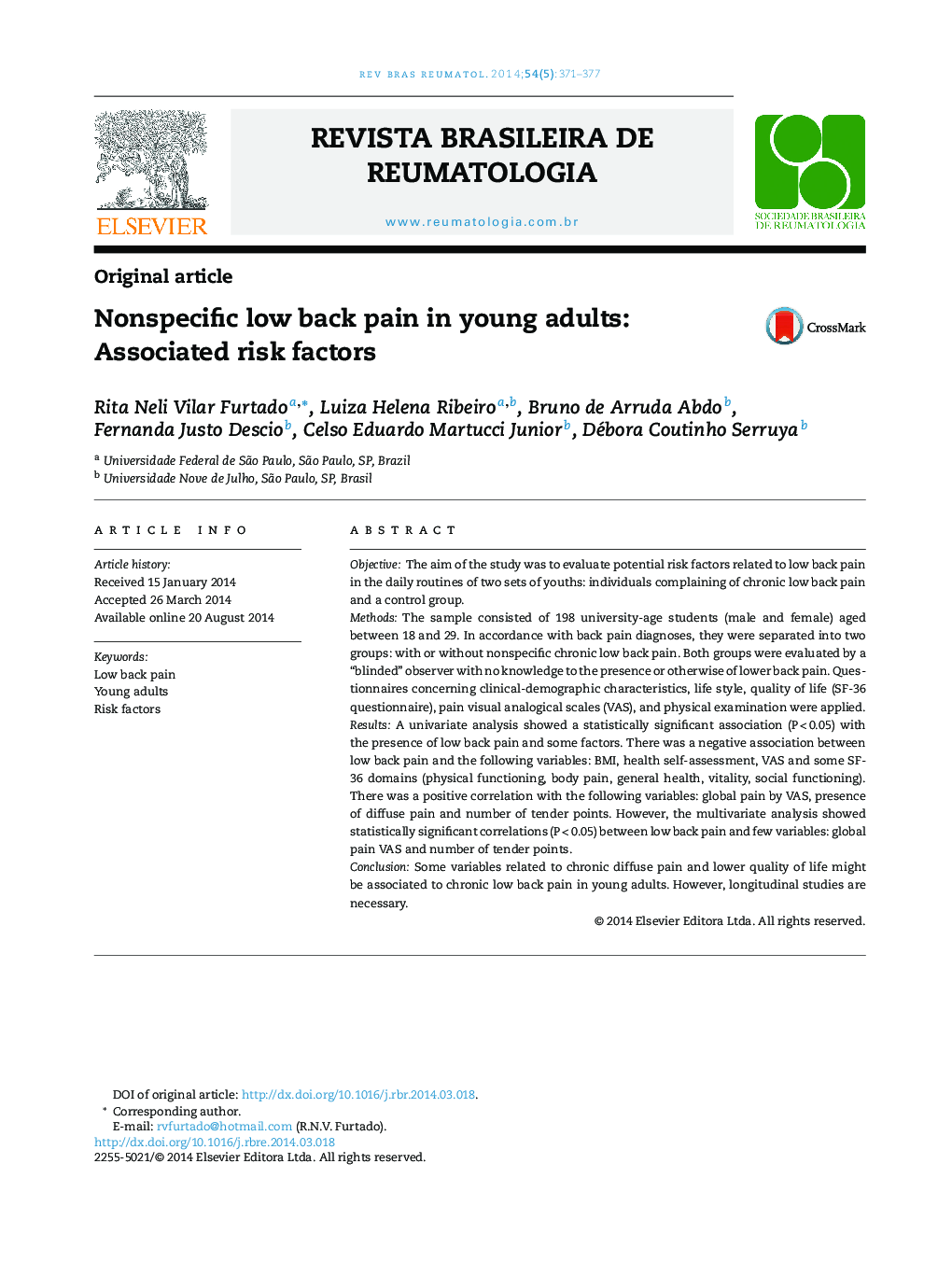| کد مقاله | کد نشریه | سال انتشار | مقاله انگلیسی | نسخه تمام متن |
|---|---|---|---|---|
| 3385132 | 1220574 | 2014 | 7 صفحه PDF | دانلود رایگان |
ObjectiveThe aim of the study was to evaluate potential risk factors related to low back pain in the daily routines of two sets of youths: individuals complaining of chronic low back pain and a control group.MethodsThe sample consisted of 198 university-age students (male and female) aged between 18 and 29. In accordance with back pain diagnoses, they were separated into two groups: with or without nonspecific chronic low back pain. Both groups were evaluated by a “blinded” observer with no knowledge to the presence or otherwise of lower back pain. Questionnaires concerning clinical-demographic characteristics, life style, quality of life (SF-36 questionnaire), pain visual analogical scales (VAS), and physical examination were applied.ResultsA univariate analysis showed a statistically significant association (P < 0.05) with the presence of low back pain and some factors. There was a negative association between low back pain and the following variables: BMI, health self-assessment, VAS and some SF-36 domains (physical functioning, body pain, general health, vitality, social functioning). There was a positive correlation with the following variables: global pain by VAS, presence of diffuse pain and number of tender points. However, the multivariate analysis showed statistically significant correlations (P < 0.05) between low back pain and few variables: global pain VAS and number of tender points.ConclusionSome variables related to chronic diffuse pain and lower quality of life might be associated to chronic low back pain in young adults. However, longitudinal studies are necessary.
ResumoObjetivoO objetivo do estudo foi avaliar fatores de risco potenciais para dor lombar na rotina diária de dois grupos de jovens: indivíduos com queixa de dor lombar e um grupo de controle.MétodosA amostra consistiu de 198 estudantes em idade universitária (homens e mulheres), entre 18 e 29 anos. De acordo com os diagnósticos de dor nas costas, os participantes foram separados em dois grupos: com ou sem dor lombar crônica inespecífica. Ambos os grupos foram avaliados por um observador “cego”, i.e. desconhecedor da presença ou de qualquer outra indicação de dor lombar. Foram aplicados questionários relativos às características clínico-demográficas, estilo de vida, qualidade de vida (questionário SF-36), dor pela escala visual analógica (EVA) e exame físico.ResultadosUma análise univariada demonstrou uma associação estatisticamente significativa (p < 0,05) entre presença de dor lombar e alguns fatores. Houve uma associação negativa entre dor lombar e as seguintes variáveis: IMC, autoavaliação da saúde/EVA e alguns domínios do SF-36 (função física, dor corporal, saúde em geral, vitalidade, função social). Houve uma correlação positiva com as seguintes variáveis: dor global por EVA, presença de dor difusa e número de pontos sensíveis. Contudo, a análise multivariada demonstrou correlações estatisticamente significativas (p < 0,05) entre dor lombar e poucas variáveis: dor global por EVA e número de pontos sensíveis.ConclusãoAlgumas variáveis relacionadas à dor difusa crônica e à má qualidade de vida podem estar associadas à dor lombar crônica em adultos jovens. Mas há necessidade de estudos longitudinais.
Journal: Revista Brasileira de Reumatologia (English Edition) - Volume 54, Issue 5, September–October 2014, Pages 371–377
